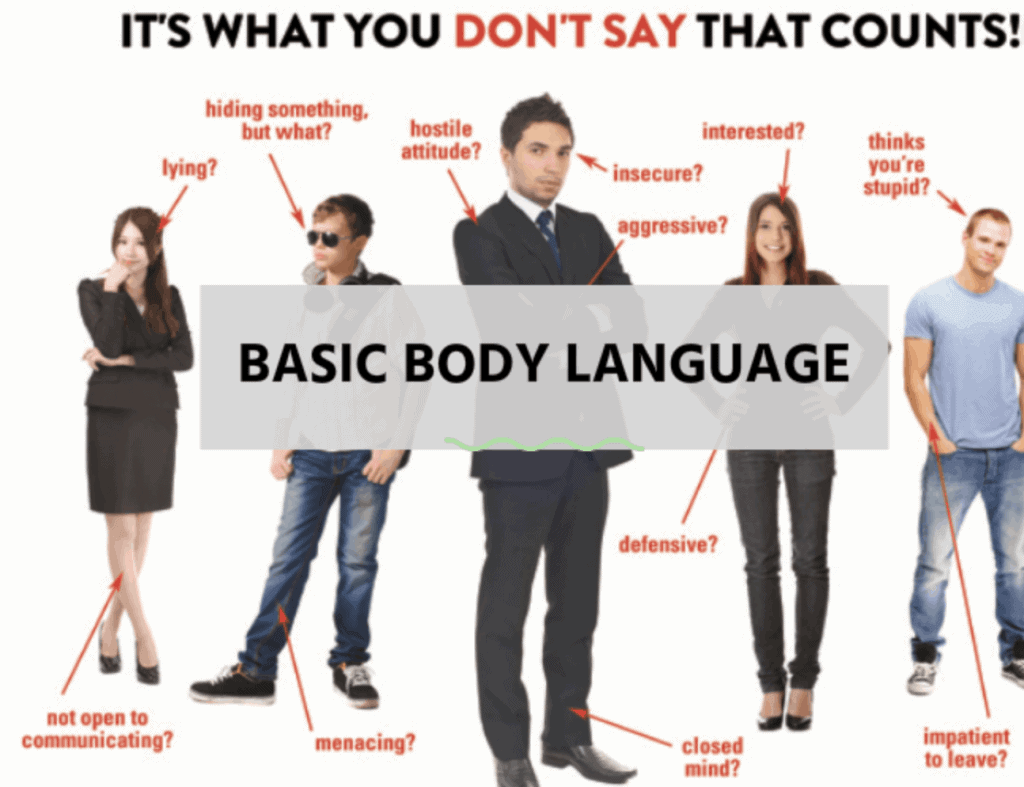Body Language Basics
What is body language?
Body language, also known as non-verbal communication, refers to the way a person uses his or her body in order to communicate thoughts and feelings. For example, when a friend pats us on the back after we fail an exam, it may be interpreted as consolation.
A light touch from a loved one in a crowded room may go totally unnoticed, but it can have a profound effect on how we feel about ourselves and the other person. Body language is said to account for over half of all meaning that comes from communications with others, whereas words themselves only account for 7%.
Body language plays an important role in our personal relationships, as well as in the workplace. It can be used to build rapport, to show interest or disinterest, to convey confidence or insecurity, and much more.
Communication Process:
The communication process involves a sender, a message and a receiver. The sender is the person who initiates the communication and they send a message to the receiver. The receiver is the person who receives the message and they interpret it based on their own experiences and understanding. This process usually happens very quickly, so it’s important that the sender is clear and concise with their message.
Nonverbal Communication and Nonverbal Signals
Nonverbal communication includes facial expressions, gestures, posture, eye contact, touch, and the use of space.
Facial Expression:
Facial expressions are one of the most important forms of nonverbal communication. They can communicate happiness, sadness, anger, fear, love, and other emotions. In some cases, they can also communicate deception.
Gestures:
Gestures are another important form of nonverbal communication. Gestures can include movements of the hands, arms, head, and body. They can be used to communicate a wide range of emotions and messages.
Posture:
Posture is another important aspect of nonverbal communication. Good posture can make a person appear confident and in control. Poor posture can make a person appear weak or insecure.
Eye Contact:
Eye contact is another important aspect of nonverbal communication. It can be used to convey interest, engagement, dominance, and other messages.
Touch:
Touch is another important form of nonverbal communication. It can be used to express affection, comfort, dominance, and other emotions.
Space:
Space is another important form of nonverbal communication. It can be used to indicate dominance or submission, to show interest in someone, or to indicate that a person wants some space.
Nonverbal signals (nonverbal communication) can be very powerful in conveying messages. Some nonverbal signals, such as a smile or a touch, are very subtle and may be easy to miss. Others, such as posture or eye contact, are more obvious.
Nonverbal cues are often very subtle and can be easily missed if you are not paying attention. However, the messages that they send can be very powerful. By being aware of the different types of nonverbal cues and what they mean, you can improve your ability to understand and interpret the messages that people are sending to you.
What are the benefits of body language?
There are many benefits to body language. Some of the benefits include:
• Body language can help you to better understand and communicate with others.
• Body language can help you to better understand and express your own emotions.
• Body language can help you to build better relationships with others.
• Body language can help you to appear more confident and in control.
• Body language can help you to feel more connected to others.
• Body language can help you to better understand the emotions of others.
• Body language can help you to better understand deception.
Developing body language in soft skills:
There are countless benefits to be gained from developing strong body language skills. Not only will you be better equipped to communicate with others, but you’ll also find that your overall communication skills will improve. In addition, strong body language skills can help you in a variety of business and personal settings, including job interviews, networking events, and social gatherings.
In order to develop strong body language skills, it’s important to first understand what they are and how they work. Body language is composed of three primary elements: posture, gestures, and facial expressions. Each of these elements can communicate a wide range of emotions and thoughts, both positive and negative. For example, when we’re feeling happy or excited, our posture is likely to be open and expansive, while our gestures may be animated and energetic. Conversely, when we’re feeling sad or anxious, our posture is likely to be closed and defensive, while our gestures may be small and restricted. Our facial expression will also betray our emotions, with a frown indicating sadness and a raised eyebrow indicating surprise.
Ultimately, developing strong body language skills takes time and practice. But with a little effort, you can start to see real results in your personal and professional life. So don’t be afraid to start experimenting with different postures, gestures, and facial expressions – you may be surprised at how well they work!
Reading body language:
Maggie Brown, in her book The Body Language Bible, goes into great detail about the different tells that people exhibit when they are feeling certain emotions. While learning to read body language does take time and practice, it can be easy for anyone to learn the basics.
One of the best ways is to combine what you already know with signals that your subject is exhibiting themselves. For example, in order to tell if someone is interested in you, simply think about how they are acting around you. If they are standing closer than usual or smiling often when they speak to you, this indicates that they may be interested in you.
Similarly, if someone keeps touching their neck gently with their index finger while speaking to you, it is likely that they are uneasy about something you said. This could be a sign that they are lying to you, or that they have something to hide. Another index finger sign is if someone rubs their eye while speaking to you. This is generally a sign of fatigue or stress, and could mean that the person is not being truthful with you.
Knowing your audience:
While it is important to be aware of the basic body language signals that people exhibit when they are feeling certain emotions, it is also important to know your audience. Each culture has its own set of body language signals, and what may be considered an acceptable way to act in one culture may not be acceptable in another.
Body language in the workplace:
Body language can be useful in the workplace as well. For example, a boss who places their hand on their chin while looking over an employee’s shoulder is likely to be giving positive feedback, but a boss who looks at their watch or taps a pencil may be less impressed with what they see.
Other common signals that someone may exhibit during a job interview or meeting include touching their lips with their fingers, leaning away from the person speaking, and repeatedly crossing and uncrossing their legs.
Legs crossed, for example, generally means that a person is not interested in what the other person is saying. But it can also depend on the culture, as in some countries it is considered polite to cross legs during a meeting.
Body language in customer service:
One of the most important aspects of customer service is how to deal with difficult customers. It is always best for employees to be patient and kind regardless of what a customer says or does, but there are certain things that can happen that give off signs that they might need some extra help.
For example, if someone has their arms tightly crossed over their chest it may indicate that they are feeling defensive or closed off. It is important to remember not to take the offensive signals of your customers personally, especially if you are doing everything in your power to help them have a good experience. The main thing is being aware of what their body language might be saying and adjusting how you interact with them accordingly.
Over the top body language:
Sometimes people send too many signals with their body language and it becomes difficult to know what they really mean. For example, if someone is speaking in a loud or angry voice, they may be trying to intimidate the person they are talking to.
Alternatively, they may just be passionate about what they are saying and not realize that their body language is giving off the wrong impression. In either case, it is important to be aware of how someone’s body language may be affecting the conversation. Another thing to remember about over the top body language is that it can be a sign of someone who is feeling insecure or uncomfortable.
If you are ever unsure about what someone’s body language is trying to say, it is always best to ask them directly. This will help ensure that everyone is on the same page and avoid any misunderstandings.
Body language in public speaking:
When giving a presentation, it is important to be aware of your body language. Your body language can communicate a lot of information to your audience, including your confidence level, your attitude, and even the content of your speech. Here are some tips for using your body language to convey the right message:
1. Make eye contact:
One of the most important things you can do to connect with your audience is to make eye contact. When you make eye contact, you are connecting with individual members of your audience and establishing a personal connection. This makes them more likely to pay attention to what you are saying and to remember it later.
2. Stand up straight:
When you stand up straight, you appear confident and in control. This will help to put your audience at ease and make them more likely to listen to what you have to say.
3. Use gestures:
Gesturing helps to keep your audience engaged and helps them to follow along with your speech. However, be careful not to use too many gestures, or else you will appear fidgety and nervous.
4. Be aware of your facial expressions:
Your facial expressions can communicate a lot to your audience, so be sure to keep them under control. Avoid making faces that will make you look uncomfortable or angry, and try to smile and look positive whenever possible.
5. Stay relaxed:
It is important to stay relaxed and natural when giving a presentation. This will help you to appear confident and in control. If you start to feel tense or nervous, take a deep breath and try to relax your muscles.
By following these tips, you can use your body language to create a positive impression with your audience and convey the message that you are an expert on the topic at hand.
Different ways of expressing love through body language
One way that you can express your feelings for someone else using only body language is simply by sitting closer than usual or brushing against them. Moving your hands slowly and gently towards them without reaching out to touch them at all can also be seen as a form of body language that means, “I want to hold you”.
Other subtle forms of love through body language include standing or sitting with your legs towards the person you are interested in and away from everyone else, drawing circles on their back gently while speaking (or getting them to speak) and resting your head on their shoulder while watching a movie can all be considered as ways to show your feelings for them without taking it too far.
Why should I use the right body language during a date or in an interview?
One of the best ways you can tell if someone is interested in you, either romantically or professionally, is by observing how they interact with you in a group. People who are interested in you will often try to include you in the conversation when they speak and when others speak, their eyes will be on them instead of being transfixed on you.
When speaking about themselves, it is also a good sign if they use pronouns such as “we” or “us” when they are speaking about themselves. Using the right body language during an interview, such as leaning in towards them when they answer a question can also be seen as a sign of interest.
How to avoid misinterpreting body language?
Some people tend to read too much into certain signals that others give off, leading them to believe things that aren’t necessarily true. One of the best ways to avoid this is by observing how body language differs between people. For example, if someone crosses their arms in front of them while speaking about something they are interested in, it could mean that they are feeling defensive or merely that they are cold.
Another way to avoid misreading signals is to take note of what somebody’s body language is like when they are with other people. If someone tends to space out or look away from the person they are speaking to, this may indicate that they are bored or don’t care about what you have to say.
What should I do if I think someone has feelings for me?
While there are many different signs that someone likes you, if you don’t feel the same way towards them then it is important to let them down gently. If you think a friend has feelings for you and would like to date them romantically, try spending time with them in a group of friends so they can see how much fun you have when they aren’t around.
If you don’t want to lead them on, try not to let your eyes linger too long when you look at them or stay close for longer than usual. Finally, if someone’s body language makes you feel tense and uncomfortable instead of relaxed and comfortable, it is probably best to sort things out as soon as possible so they don’t get the wrong idea.
Decoding actions using Psychology: Read Body Language
In the case of body language, the most obvious sign that someone has romantic feelings for you is if they keep touching you or trying to get your attention. They may also stand a little bit too close, perhaps by standing directly in front of you while speaking so that they can’t look at anyone else.
One way of avoiding misunderstanding in the case of body language is to observe how a person behaves when they are with other people. If someone stares blankly into space or appears distracted while speaking, it may be because they aren’t that interested in what you have to say.
Lastly, if somebody’s body language makes you feel uncomfortable instead of relaxed and comfortable, they may have feelings about you that you don’t share. For example if someone stands too close to you it could be a sign that they would like to date you romantically or it could be a sign that they are cold and need some space from the heating.
Negative body language / Negative nonverbal signals
-If someone’s body language makes you feel tense and uncomfortable instead of relaxed and comfortable, it is probably best to sort things out as soon as possible so they don’t get the wrong idea.
-If someone stands too close to you, it could be a sign that they would like to date you romantically or it could be a sign that they are cold and need some space from the heating.
-If someone stares blankly into space or appears distracted while speaking, it may be because they aren’t that interested in what you have to say.
As for the workplace, here are some negative body language signals to watch out for:
-Slouching in your chair or crossing your arms across your chest can make you look uninterested or defensive.
-Avoiding eye contact may make it seem like you’re not listening or hiding something.
-Playing with your hair, fidgeting with your hands or picking at your clothes can be a sign of nervousness or insecurity.
-Leaning back in your chair can make you seem uninterested or arrogant.
-Tapping your foot or drumming your fingers can be seen as impatient or aggressive.
-A furrowed brow can indicate displeasure or confusion, and raised eyebrows can show interest.
-Smiling too much or laughing at everything the other person says may make you seem insincere or fake.
-Closing your eyes or turning your head away can indicate that you’re not interested in what’s being said.
-Clenched jaw, tight lips or pursed lips can signal anger, frustration or disappointment.
-Scratching your nose or rubbing your eyes can mean you’re tired or bored.
-Staring at someone for too long can be seen as aggressive or intimidating.

20 types of body language:
While there are many types of body language, the 20 key ones are:
1. Open posture/Happiness
2. Closed posture/Unhappiness or fear.
3. A person’s feet position in relation to your own, known as ‘vectoring’. This can indicate whether they want to get closer (if their feet are pointing towards you), or if they want to get away.
4. The direction in which a person is looking, as well as eye contact, displays interest levels.
5. How far a person leans into your personal space also indicates how comfortable they are around you and if they like you. This is closely related to vectoring.
6. Facial expressions, which include teeth exposure and lip licking, can display a variety of emotions like happiness, fear or nervousness. You may also notice that people tend to mimic each other’s facial expressions as they feel comfortable around one another (e.g. if person A is smiling at person B, person B will return the smile).
7. Body fidgeting. This indicates a lack of self-confidence, or discomfort with their surroundings.
8. Touching an object in front of them (e.g. table) shows confidence and is often seen when people want to make a point during a conversation, while folding arms means they feel closed off.
9. Neck touching is usually a sign of nervousness, although it can also indicate that they are lying or have something to hide.
10. Lip licking or biting, especially when combined with looking away displays signs of being dishonest or feeling guilty about something they’ve done.
11. Tight lips together with frowning eyebrows means they are unhappy or angry.
12. Sniffing, rubbing the nose or clearing of throat during a conversation can indicate lying as these are all typical signs of lying.
13. Chin stroking is another sign that someone may be lying, as it’s often done unconsciously when people think about a lie they have just told, and means that they are trying to work out how believable it was.
14. Laughing is another important form of non-verbal communication, as depending on the laughter and its volume/tone/length, it can indicate whether a person is nervous or that they find something funny. Also pay attention to when people laugh in relationships – often one half will laugh at their partner’s jokes to stop them feeling hurt.
15. Yawning, especially in groups of people together is a sign that they are feeling tense and have been talking for too long. It can also mean that everyone is bored or that the speaker has lost their audience’s attention, so should probably move on to something else!
16. Moving towards you is seen as a sign of interest. A person who likes what they are hearing will move closer to the speaker, while someone who has no interest in what is being said or doesn’t agree with it will lean or move away.
17. Mirroring – when people copy each other’s movements subconsciously, especially in professional relationships between managers and colleagues.
18. Head tilting and nodding along with smiling shows that they like the person talking to them, while not doing this can mean they are disinterested or think what is being said isn’t true.
19. Tapping fingers/toes/pen on a table or twiddling thumbs during a conversation usually means that the person is bored.
20. Playing with an object shows a lack of interest or boredom, whereas playing with their hair or touching their face/nose indicates they are either lying or nervous.
Other useful tips to know about include:
- Physical distance: People generally feel comfortable when there is an arm’s length of space between them and the other person. When someone gets closer than this, it can be seen as a sign of intimacy or interest.
- Genuine smile: A genuine smile is one that reaches the eyes and is often accompanied by a crinkling around them. A fake smile, on the other hand, is just a mouth-only smile and doesn’t involve the eyes.
- Prolonged eye contact: When two people are talking and one looks away, it can be interpreted as a sign of lying, boredom or lack of interest. However, if the person looks down after a brief moment of eye contact, it usually means that they are shy or uncomfortable.
- Hand gestures: Hand gestures can indicate a lot about a person’s mood and intentions. For example, if someone is talking with their hands in their pockets, it usually means they are feeling relaxed and comfortable. If a person has their arms crossed or is tapping their fingers on a table, it usually means they are feeling impatient or nervous.
- Body movement: Body movement can also be indicative of a person’s feelings or intentions. For example, if someone is leaning away from you while they are talking, it usually means they are not interested in what you have to say. If a person is fidgeting or playing with their hair, it often means they are feeling nervous or uncomfortable.
- Nervous system: The autonomic nervous system controls all the unconscious body functions, such as heart rate, breathing and digestion. When a person is feeling nervous or tense, it often shows in their physical behaviour, such as an increased heart rate, blotchy skin and sweaty palms.
- Conscious awareness: This is the ability to be aware of your own thoughts and feelings, as well as the thoughts and feelings of others. When a person is good at this, they can often pick up on the non-verbal signals that people are sending.
- Shake hands: A handshake is a common way to greet someone and it usually involves shaking the other person’s hand for a few seconds. When you shake someone’s hand, you should make eye contact and smile. If you don’t want to shake someone’s hand, you can politely decline by saying “no thank you”.
- Slight smile: A slight smile is often used as a way to show that you are friendly or interested in the other person. It is not as intense as a genuine smile and usually doesn’t involve the eyes.
- Neck signals: Neck signals can be a way to show whether someone is interested in what you are saying. For example, if a person is nodding their head along with your conversation, it usually means they are interested and listening. If a person is tilting their head to one side, it usually means they are confused or have questions about what you are saying.
- Pupil dilation: When a person is interested in something, their pupils will dilate (enlarge). This is because the pupil is controlled by the autonomic nervous system, which is also responsible for things like heart rate and sweating. So, by monitoring someone’s pupil size (aka pupil dilation), you can get an idea of how interested they are in what you are saying.
- Social distance: The social distance between two people is the amount of space that is usually kept between them. When someone gets too close, it can be seen as a sign of intimacy or interest.
- Eyes downcast: When a person is feeling shy or uncomfortable, they will often look downcast. This means that they will avoid making eye contact with the other person and will keep their head down.
- Arms akimbo: When a person has their arms akimbo, it usually means they are feeling defensive or aggressive. This is because when we are feeling threatened or uncomfortable, we often cross our arms over our chest as a way to protect ourselves.
- Pursed lips: When a person has their lips pursed, it usually means they are unhappy or angry. This is because when we are upset, we often clench our teeth and purse our lips as a way to control our emotions.
- Crossed arms: When a person has their arms crossed, it usually means they are feeling defensive, angry or impatient. This is because when we are feeling threatened or uncomfortable, we often cross our arms over our chest as a way to protect ourselves.
Other key forms of nonverbal cues include: fiddling with jewellery (trying to hide nervousness), biting nails (stress/insecurity), wringing hands together (nervousness), scratching the ear or behind the ear near the neck (deceitfulness/uncomfortableness), playing with hair/necklaces/bracelets (trying to hide nervousness), touching their face while talking (insecurity) and placing hands on hips whilst talking to someone else (dominance).
There are a number of different non-verbal signals that people use to communicate their feelings and intentions. By being aware of these signals, you can get a better understanding of what the other person is thinking or feeling. So, next time you’re in a social situation, take note of the non-verbal signals that people are sending and see if you can decode them!
Unspoken signals: Although non-verbal signals are often called “unspoken”, they are actually quite loud. In fact, studies have shown that up to 93% of our communication is non-verbal. This means that if you are good at reading body language, you will be able to understand what a person is really saying, even if they aren’t speaking out








